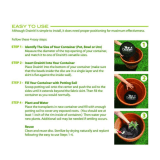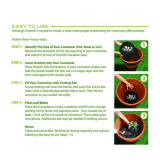Page is loading ...

GO TO BONNIEPLANTS.COM FOR MORE TIPS ON VEGETABLE AND HERB GARDENING
HOW TO GROW WiTH
FIRST THINGS FIRST. Your plants may arrive dry and thirsty. Give
them a drink, watering until the pot turns dark brown. Keep plants in
a bright spot protected from cold, and plant after the last frost. Follow
planting directions on the pot label or see the video at bonnieplants.com/
growing/growing-peppers.
PEPPERS
GETTING STARTED
People who think they don’t like peppers of-
ten change their minds once they have tast-
ed fully ripened, garden-grown peppers. By
growing an assortment of pepper varieties,
you can have mild, meaty peppers for sal-
ads and stir-fries, slightly spicy peppers for
fresh salsas, and hot peppers for bold jolts
of flavor. Growing an assortment also helps
ensure that you have peppers ripening all
through the season. For example, under hot
summer conditions, varieties that bear huge
fruits (such as bells) may temporarily shed
their blossoms, but small, thin-walled pep-
pers (such as bananas) often keep going
strong. Similarly, small-fruited peppers ripen
faster, which is important in cool climates
where summers are short.
Having a late cold spell? If planting
is delayed due to cool weather in spring,
keep your seedlings indoors at night and
move them to a protected sunny spot
outdoors during the day. While you await
better planting conditions, you also can try
this trick: Place 2 inches of moist potting
soil in a 6-inch-wide container, gently
break open the bottom of the biodegrad-
able Bonnie pot, and nestle the pepper
seedling (one per container) into the soil
about 1 inch deep. A bit of extra down-
ward growing room will ensure that each
plant’s primary taproot has ample space
for expansion. Later on, after you plant the
pepper outside, this taproot will become
the plant’s lifeline.
PLANTING
Peppers are easy to grow in any sunny,
well-drained spot, and they are good candi-
dates for roomy containers, too. Set plants
out a week or two after your last frost, when
the weather is settled and the temperature
warms. All peppers share a preference for
a long, warm growing season. Peppers
have a naturally upright growth habit, so
they often benefit from staking, which keeps
branches from breaking when they become
heavy with fruit. Install stakes or cages at
planting time. Follow spacing guidelines
found on the plant’s stick tag.
Prepare the soil. Peppers grow best
in near-neutral soil with a pH between 6.2
and 7.0, although they can tolerate slightly
alkaline conditions up to 7.5. Mix a 3- to
5-inch layer of compost into each planting
hole. A generous amount of organic matter
provides nutrients and helps the soil retain
moisture.
Plant right. Set plants at the same
depth at which they are growing in their
containers. After planting, water well,
then mulch each plant to keep the soil
cool and moist.
Grow in containers. Peppers are easy
to grow in pots if you use a big container
(18 to 24 inches in diameter). Fill it with
premium quality potting mix and mix in
some compost. Keep the soil moist so the
plant grows full-sized, healthy fruit.
FERTILIZING
Feed at planting with Bonnie Herb,
Vegetable & Flower Plant Food to give
peppers a healthy boost. They will love
the naturally based formula made from
oilseed extract. Follow label directions—
don’t overdo it. Continue to apply every
1 to 2 weeks.

GO TO BONNIEPLANTS.COM FOR MORE TIPS ON VEGETABLE AND HERB GARDENING
ABOUT PEPPER HEAT LEVELS
While you can blindly taste a pepper
to determine its heat, that’s not a rec-
ommended method—ouch! Instead,
use the Scoville scale. Pepper heat is
measured in Scoville Heat Units, with
the hottest peppers having the high-
est numbers. You’ll see these numbers
listed for all of the hot peppers on
our website.
The range of Scoville units
typically used to call a pepper mild,
medium, hot, or extra hot are:
Mild (100 to 2,500)
Medium (2,500 to 30,000)
Hot (30,000 to 100,000)
Extra Hot (100,000 to 300,000+)
Here are the heat levels for some
popular hot peppers:
n
Habanero:
Extra Hot (100,000 to 300,000)
n
Tabasco:
Hot (30,000 to 50,000)
n
Cayenne:
Hot (30,000 to 50,000)
n
Jalapeño:
Medium (2,500 to 5,000)
n
Poblano (Ancho):
Mild (1,000 to 2,000)
–––––––––––––––––––––––––––––––––––––––––––––––––––
WHAT COLOR SHOULD MY
PEPPERS BE?
As peppers change from green to
yellow, orange, or red, both their
flavor and their vitamin content
improve dramatically. This means
that sweet peppers get sweeter, and
hot peppers get hotter. For specific
information about the ripe color of
your varieties, consult the variety
descriptions on our website.
–––––––––––––––––––––––––––––––––––––––––––––––––––
RECIPES
With so many varieties, types, and
flavors of peppers, there are endless
ways to use them in the kitchen.
Whether you want to eat them fresh,
cooked, dried, or pickled, go to
bonnieplants.com/cooking to
find recipes for your pepper harvest.
TROUBLESHOOTING
Peppers have few serious pest problems,
and common pepper diseases can be
prevented by growing resistant varieties.
Plants that look frail and stringy may be
infected with viruses, which are spread by
aphids and other small insects. Chronically
thirsty peppers may be troubled by root-
knot nematodes.
Gardeners in warm climates may need
to be patient with big bell and sweet roast-
ing pepper plants, which can often pause
production in hot weather. When nights
become longer and cooler in late summer,
they should resume loading up with fruit.
The wait will go by faster if you have less
flashy (yet really productive) banana pep-
pers to combine with tomatoes and basil in
cool summer salads while bigger varieties
take their time ripening.
HARVESTING & USING
Use pruning shears or a sharp knife to
cut peppers with a short stub of stem
attached. Don’t pull peppers by hand,
which can cause the entire branch to
break off. Rinse peppers with water, pat
them dry, then store them in the refrigera-
tor. Fruits that are not eaten fresh can
be dried, frozen, or pickled. Peppers
harvested in cool fall weather may have
just begun to change colors and will often
continue to ripen for up to 3 days when
kept in a warm room indoors. Watch for
signs of softening, and promptly refriger-
ate or use fruits that begin to shrivel. A
pepper plant may have numerous green
fruits when the first freeze kill it. Very im-
mature peppers often taste bitter, so it is
better to compost them than to serve them
for dinner.
PEPPERS
Small wire tomato
cages make good
supports for large
pepper plants.
LIKE. LEARN. SHARE.
GROW WITH BONNIE PLANTS.
Facebook “f” Logo CMYK / .ai Facebook “f” Logo CMYK / .ai
• ACCESS TO EXPERTS through our Ask an
Expert service
• HELPFUL INFORMATION on how to care for
your vegetable and herb plants
•
ON THE GO? Grow these plants with help
from our free app for iPhone and Android,
Homegrown with Bonnie Plants. Find out more at
bonnieplants.com/app.
BONNIEPLANTS.COM
/








